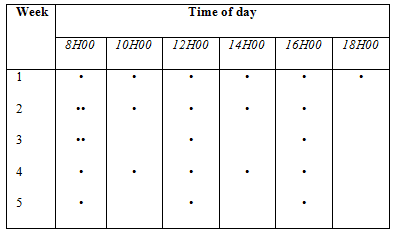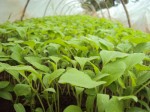Seedling irrigation and fertilization
Seedlings must be irrigated and fertigated with micro sprinklers which are linked to a timer. A simple swimming pool timer will suffice.
In arid conditions the seedlings should be irrigated as listed in the table below. Fertilizers should only be applied in the second and third week of growth. Most seedlings should be ready for transplanting within four weeks except peppers and brinjals which may take as long as six to seven weeks (depending in temperatures) to be ready for transplanting.
The fertilizers used with seedlings are high in nitrogen such as calcium nitrate (CaNO3), potassium nitrate (KNO3) and mixes such as 1:0:1(49). Never use fertilizers which have ammonia in them such as
- LAN (limestone ammonia nitrate)
- MAP (mono ammonium phosphate)
- guano and
- ammonium nitrate (NH2NO3).
Seedlings are very sensitive to ammonia fertilizers and if exposed to the chemical it will burn the root system.
It is extremely important that the irrigation system used should apply water evenly over the seed trays. This will ensure uniform growth of seedlings. It does not matter if neighbouring sprinklers overlap. See our section on the basic layout of seedling nursery irrigation system.

Irrigation schedule for seedlings grown in a commercial seedling mix planted in a 200 plug polystyrene tray. The one dot denotes that water should be applied and two dots water and fertilizers (Typical for tomatoes, peppers, lettuce, cabbage and spinach).
Nutrients can be injected through the seedling irrigation system or it can be added by hand. An easy method is to use a venturi system which sucks the nutrients out of a nutrient tank and mixes it in the irrigations line. If nutrients are to be injected through the irrigation system, water soluble fertilizers should be used and not the granular type. Water soluble fertilizers that are suitable for seedlings are:
- Chemicult – 5g.10L-1
- Hydroponica – 5g.20L-1
- Calcium Nitrate (CaNO3) – 2.5g.20L-1
If however granular type are to be used, one should be careful to distribute the granules very evenly over the trays. It is more efficient to use water soluble fertilizers dissolved in a water can than trying to spread granular fertilizers evenly over small seedling trays. Granular fertilizers work best in seedbeds (a seedbed is where seedlings are sown directly into the soil and where the soil is especially prepared for the seedlings). The use of granular fertilizers tend to cause the build-up of algae on the surface of the growth medium which attracts fungus gnats and other insects. After applying the fertilizer, make sure to rinse the leaves for approximately one minute with clean water. Seedlings should never receive ammonium as source of nitrogen.




